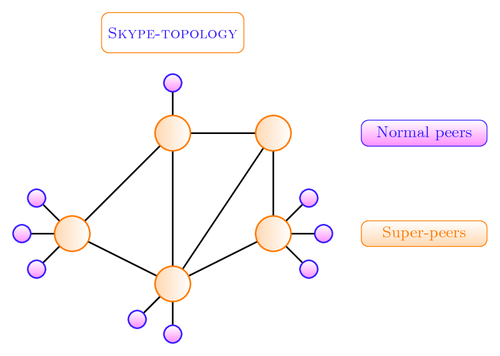Skype uses a decentralized network topology with super nodes and normal clients. This diagram shows the architecture.

Edit and compile if you like:
% Skype network topology
% Author Fiandrino Claudio 2011
% http://claudiofiandrino.altervista.org/
\documentclass{article}
\usepackage{tikz}
\usepackage[active,tightpage]{preview}
\PreviewEnvironment{tikzpicture}
\setlength\PreviewBorder{7pt}
\definecolor{lavander}{cmyk}{0,0.48,0,0}
\definecolor{violet}{cmyk}{0.79,0.88,0,0}
\definecolor{burntorange}{cmyk}{0,0.52,1,0}
\def\lav{lavander!90}
\def\oran{orange!30}
\tikzstyle{peers}=[draw,circle,violet,bottom color=\lav,
top color= white, text=violet,minimum width=10pt]
\tikzstyle{superpeers}=[draw,circle,burntorange, left color=\oran,
text=violet,minimum width=20pt]
\tikzstyle{legendsp}=[rectangle, draw, burntorange, rounded corners,
thin,bottom color=\oran, top color=white,
text=burntorange, minimum width=2.5cm]
\tikzstyle{legendp}=[rectangle, draw, violet, rounded corners, thin,
bottom color=\lav, top color= white,
text= violet, minimum width= 2.5cm]
\tikzstyle{legend_general}=[rectangle, rounded corners, thin,
burntorange, fill= white, draw, text=violet,
minimum width=2.5cm, minimum height=0.8cm]
\begin{document}
\begin{tikzpicture}[auto, thick]
% Place super peers and connect them
\foreach \place/\name in {{(0,-1)/a}, {(2,0)/b}, {(2,2)/c}, {(0,2)/d},
{(-2,0)/e}}
\node[superpeers] (\name) at \place {};
\foreach \source/\dest in {a/b, a/c, a/d, b/c, c/d,a/e,d/e}
\path (\source) edge (\dest);
%
% Place normal peers
\foreach \pos/\i in {above left of/1, left of/2, below left of/3}
\node[peers, \pos = e] (e\i) {};
\foreach \speer/\peer in {e/e1,e/e2,e/e3}
\path (\speer) edge (\peer);
%
\foreach \pos/\i in {above right of/1, right of/2, below right of/3}
\node[peers, \pos =b ] (b\i) {};
\foreach \speer/\peer in {b/b1,b/b2,b/b3}
\path (\speer) edge (\peer);
%
\node[peers, above of=d] (d1){};
\path (d) edge (d1);
%
\foreach \pos/\i in {below left of/1, below of/2}
\node[peers, \pos =a ] (a\i) {};
\foreach \speer/\peer in {a/a1,a/a2}
\path (\speer) edge (\peer);
%%%%%%%%
% Legends
\node[legendsp] at (5,0) {\small{Super-peers}};
\node[legendp] at (5,2) {\small{Normal peers}};
\node[legend_general] at (0,4) {\small{\textsc{Skype-topology}}};
\end{tikzpicture}
\end{document}
Click to download: skype-topology.tex • skype-topology.pdf
Open in Overleaf: skype-topology.tex

